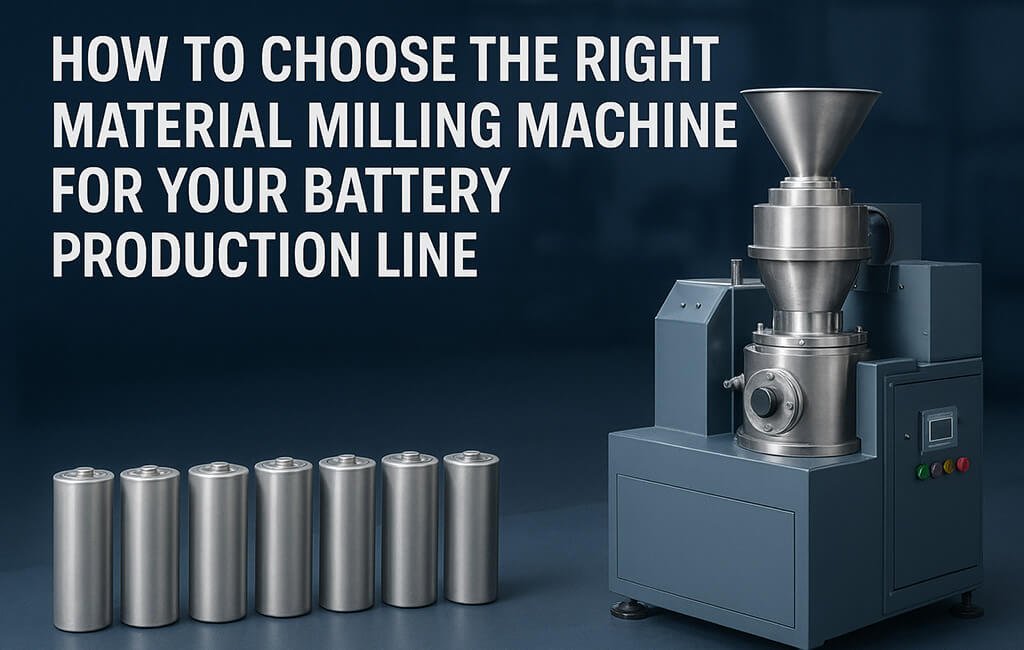Selecting the appropriate material milling machine represents a critical decision in battery manufacturing. The choice directly impacts electrode performance, energy density, and production efficiency. The milling process determines particle size distribution, material homogeneity, and contamination levels that ultimately affect battery capacity and cycle life.
Modern battery production demands precise control over material properties across diverse chemistries. These include lithium iron phosphate (LFP), nickel manganese cobalt (NCM), and graphite-based anodes. This guide examines the technical specifications, selection criteria, and integration requirements for material milling machines in battery manufacturing environments.
Material Milling Machine Types and Applications
Battery material processing requires specialized milling equipment capable of achieving precise particle size distributions while maintaining material purity. The selection between different milling technologies depends on material properties, target particle sizes, and production volumes.
Jet Mills
Jet mills utilize compressed gas streams to accelerate particles into collision zones. This process achieves particle sizes below 10 micrometers without mechanical contact. The technology proves essential for processing heat-sensitive cathode materials and maintaining contamination-free environments.
Operating parameters include gas pressure ranges of 6-10 bar and feed rates of 50-500 kg/h. Classifier speeds range from 3,000-15,000 rpm. Temperature control systems maintain process temperatures below 40°C to prevent material degradation.
Ball Mills
Ball mills employ rotating cylinders containing grinding media to reduce particle sizes through impact and attrition. Wet ball milling enables simultaneous particle size reduction and slurry preparation for electrode coating processes.
Critical specifications include mill volumes from 50 to 5,000 liters and rotation speeds of 15-35 rpm. Media-to-material ratios range from 3:1 to 10:1. Ceramic or zirconia grinding media minimize metallic contamination in battery materials.
Roller Mills
Roller mills compress materials between rotating cylinders, providing consistent particle size reduction with minimal heat generation. These systems excel in processing graphite and silicon-based anode materials requiring controlled flake structures.
Key parameters encompass roller pressures of 50-150 MPa and gap settings from 0.1 to 2.0 mm. Throughput capacities range from 100-2,000 kg/h. Integrated classification systems ensure particle size uniformity.
What Particle Size Distribution Is Required for Battery Materials?
Battery materials require specific particle size distributions to optimize electrochemical performance. Cathode materials typically need D50 values between 3-15 micrometers, while anode materials range from 10-25 micrometers. The D10/D50/D90 ratios must remain within tight tolerances to ensure consistent electrode coating and battery performance.
| Material Type | D10 (μm) | D50 (μm) | D90 (μm) | Span (D90-D10)/D50 | Application Notes |
|---|---|---|---|---|---|
| NCM Cathode | 2-4 | 8-12 | 18-25 | <2.0 | EV applications require tighter distribution |
| LFP Cathode | 0.5-2 | 3-6 | 8-12 | <2.5 | Energy storage systems tolerate wider span |
| Graphite Anode | 5-8 | 15-20 | 28-35 | <1.8 | Spheroidization may follow milling |
| Silicon Anode | 0.1-0.5 | 0.8-2 | 3-5 | <3.0 | Nano-sizing reduces volume expansion |
| Solid Electrolyte | 0.3-1 | 2-5 | 7-10 | <2.0 | Uniform distribution critical for conductivity |
Contamination Control and Material Purity
Metallic contamination during milling directly impacts battery safety and performance. Iron contamination levels must remain below 50 ppm for cathode materials and 100 ppm for anode materials. These limits prevent internal short circuits and capacity fade.
Contamination Prevention Methods
Material contact surfaces require specialized coatings or construction materials. Tungsten carbide, ceramic, or polymer linings prevent metal pickup during milling operations. Magnetic separation systems remove ferrous contaminants, while enclosed processing environments minimize airborne contamination.
Regular contamination monitoring employs ICP-OES analysis of milled samples at 2-hour intervals. Cleaning protocols between material changes include dry nitrogen purging and ultrasonic cleaning of removable components. Validation sampling ensures quality before production resumption.
Moisture Control Requirements
Moisture content significantly affects milling efficiency and material properties. Cathode materials require moisture levels below 500 ppm, while certain anode materials tolerate up to 1000 ppm. Integrated drying systems or inert atmosphere processing maintain appropriate moisture levels throughout milling operations.
Dew point monitoring systems maintain processing environments at -40°C or lower. Material pre-drying at 120-180°C for 4-8 hours removes surface moisture before milling. Post-milling storage in moisture-barrier packaging prevents reabsorption.
How to Calculate Required Milling Throughput?
Throughput calculations depend on annual production targets, material utilization rates, and equipment availability. A 1 GWh/year battery production line processing NCM cathode materials requires approximately 1,800 tons of milled material annually. This translates to 250 kg/h continuous operation at 85% equipment availability.
The calculation formula incorporates material density, target particle size reduction ratio, and milling efficiency factors:
Throughput (kg/h) = (Annual Capacity × Material Loading) / (Operating Hours × Efficiency × Yield)
Equipment Integration and Production Line Workflow
Material milling machines must integrate seamlessly with upstream raw material handling and downstream electrode processing equipment. Automated material transfer systems, process control integration, and quality monitoring create continuous production flows.
Upstream Integration
Raw material feeding systems require volumetric or gravimetric feeders capable of ±1% accuracy. Pneumatic conveying systems transport materials from storage silos while maintaining inert atmospheres for moisture-sensitive materials. Pre-screening removes oversized particles that could damage milling equipment.
Material blending systems homogenize multiple raw materials before milling. Inline moisture analyzers trigger automatic drying sequences when specifications exceed limits. Buffer storage capacities of 2-4 hours enable continuous operation during upstream maintenance.
Downstream Integration
Milled material classification systems separate on-specification particles from oversized materials requiring additional processing. Pneumatic or mechanical conveyors transport classified materials to intermediate storage or directly to coating equipment.
Quality control sampling points enable real-time particle size analysis using laser diffraction. Automated diversion systems redirect off-specification materials for reprocessing. Integration with manufacturing execution systems (MES) ensures traceability throughout the production process.
Selection Criteria Framework
Systematic evaluation of milling equipment requires consideration of technical specifications, operational requirements, and long-term performance factors. The following decision matrix guides equipment selection based on specific production requirements.
Technical Specifications Assessment
Primary technical criteria include particle size capabilities, throughput ranges, and contamination control features. Secondary factors encompass energy consumption, maintenance accessibility, and automation compatibility.
| Selection Criteria | Weight Factor | Jet Mill | Ball Mill | Roller Mill | Pin Mill |
|---|---|---|---|---|---|
| Particle Size Range | 25% | 0.5-20 μm | 1-50 μm | 10-200 μm | 20-500 μm |
| Contamination Risk | 20% | Very Low | Medium | Low | Medium |
| Energy Efficiency | 15% | Medium | Low | High | High |
| Throughput Range | 15% | Low-Medium | Medium-High | High | Medium |
| Maintenance Requirements | 10% | Low | High | Medium | Medium |
| Temperature Control | 10% | Excellent | Good | Good | Fair |
| Moisture Sensitivity | 5% | Excellent | Poor | Good | Good |
Operational Requirements
Production volumes, material changeover frequency, and quality specifications influence equipment selection. High-volume operations favor continuous processing systems. Research facilities benefit from flexible batch processing capabilities.
Maintenance accessibility impacts production availability. Quick-release grinding chambers, automated cleaning systems, and predictive maintenance sensors minimize downtime. Spare parts availability and technical support capabilities affect long-term operational costs.
Quality Control Parameters and Testing Methods
Comprehensive quality control ensures milled materials meet specifications for battery performance. Real-time monitoring and periodic laboratory analysis verify particle size distribution, contamination levels, and material properties.
Inline Monitoring Systems
Laser diffraction analyzers provide continuous particle size measurement with 30-second update intervals. Acoustic emission sensors detect abnormal milling conditions before product quality deterioration. Temperature and pressure monitoring prevents equipment damage and material degradation.
Statistical process control (SPC) software tracks quality trends and triggers alarms for out-of-specification conditions. Data historians archive process parameters for troubleshooting and continuous improvement initiatives.
Laboratory Testing Protocols
Hourly samples undergo comprehensive analysis including particle size distribution, specific surface area, and tap density measurements. Weekly contamination analysis using ICP-OES detects metallic impurities at ppb levels.
Material morphology examination via SEM imaging confirms particle shape consistency. XRD analysis verifies crystalline structure preservation during milling. Electrochemical testing of sample electrodes validates material performance in battery applications.
Maintenance Procedures and Troubleshooting
Systematic maintenance programs maximize equipment availability and product quality consistency. Preventive maintenance schedules, condition monitoring, and rapid troubleshooting protocols minimize production disruptions.
Preventive Maintenance Schedule
Daily inspections include vibration monitoring, temperature checks, and visual examination of product quality. Weekly maintenance encompasses lubrication, filter replacements, and classifier cleaning. Monthly procedures involve comprehensive equipment calibration and wear component measurements.
Annual overhauls include complete disassembly, wear part replacement, and alignment verification. Maintenance intervals adjust based on processed material abrasiveness and production volumes. Digital maintenance management systems track component life and schedule preventive activities.
Common Issues and Solutions
- Particle size drift: Check classifier speed, grinding media wear, feed rate consistency
- Contamination spikes: Inspect liner integrity, verify cleaning procedures, analyze raw materials
- Reduced throughput: Evaluate moisture content, screen condition, air flow rates
- Temperature excursions: Verify cooling system operation, check material feed rate, inspect bearings
- Excessive vibration: Balance rotating components, check mounting bolts, inspect couplings
- Product agglomeration: Adjust humidity control, verify anti-caking agent addition, check classifier operation
- Inconsistent particle distribution: Calibrate feed system, verify grinding media condition, check air flow patterns
Safety and Regulatory Compliance
Battery material milling operations require comprehensive safety protocols addressing dust explosion risks, chemical exposure hazards, and equipment safety features. Regulatory compliance encompasses environmental emissions, workplace exposure limits, and product quality standards.
Explosion Prevention Systems
Inert gas blanketing prevents dust explosions in systems processing combustible materials. Nitrogen atmospheres maintain oxygen levels below 8% during milling operations. Explosion suppression systems detect pressure rises and inject suppressants within milliseconds.
Grounding and bonding systems eliminate static electricity accumulation. Intrinsically safe electrical components prevent ignition sources. Dust collection systems maintain airborne concentrations below 25% of lower explosive limits.
Environmental Controls
HEPA filtration systems capture particles down to 0.3 micrometers with 99.97% efficiency. Activated carbon adsorbers remove organic vapors from exhaust streams. Continuous emissions monitoring ensures compliance with air quality regulations.
Waste minimization strategies include material recycling, solvent recovery, and filter media regeneration. Environmental management systems track resource consumption and waste generation for sustainability reporting.
Glossary
- D50 (Median Particle Size)
- The particle diameter at which 50% of the sample volume consists of smaller particles, measured via laser diffraction or sedimentation analysis.
- Specific Surface Area (SSA)
- Total particle surface area per unit mass, typically measured in m²/g using BET nitrogen adsorption methods, indicating material reactivity.
- Classifier
- Integrated separation device using centrifugal or gravitational forces to segregate particles by size, ensuring consistent product specifications.
- Grinding Media
- Balls, beads, or rods used in milling equipment to transfer kinetic energy to materials, available in steel, ceramic, or polymer compositions.
- Particle Size Distribution (PSD)
- Statistical representation of particle sizes within a sample, characterized by D10, D50, and D90 values indicating cumulative volume percentages.
- Tap Density
- Bulk density of powder after standardized tapping procedure, measured in g/cm³, indicating material packing characteristics in electrodes.
- Dew Point
- Temperature at which moisture condenses from processing atmosphere, maintained below -40°C to prevent material moisture absorption.
- ICP-OES
- Inductively Coupled Plasma Optical Emission Spectroscopy, analytical technique detecting metallic contamination at parts-per-billion sensitivity levels.
Conclusion
Selecting the optimal material milling machine for battery production requires systematic evaluation of technical specifications, operational requirements, and quality objectives. The integration of particle size control, contamination prevention, and process monitoring capabilities determines production efficiency and product quality.
Successful implementation depends on matching equipment capabilities to specific material requirements while maintaining flexibility for future production needs. Regular maintenance, comprehensive quality control, and continuous process optimization ensure consistent delivery of high-performance battery materials. These practices support the global transition to sustainable energy storage.



